individual goals, but also on other related measurements like initiatives
taken, or exercise time, etc.
Coaching strategies can help clients maintain new behaviors and make
future changes.
After lining up the perfect coaching plan with your target clientele,
creating a sound lesson plan, organizing your packages and procedures
and devising great materials and tools, what do you do next? The last
step in carving out your coaching niche is often the
hardest—supporting clients in maintaining the changes they have
made and helping them continue to progress. What should your
ongoing expectations be, and how do you encourage them to maintain
behavioral change? When you graduate clients from weekly coaching,
do you continue to coach them on an infrequent basis? To “ACE” your
role as a coach, learn to support your clients’ forward progress through
Accountability, Contact and Encouragement.
Accountability
The accountability of one person to another is often the largest factor in
successful behavior change. Knowing that you have someone to answer
to who cares about your progress is a huge motivator in making change.
Most people find change in life scary and uncomfortable. To get past the
status quo, to let go of less than optimal habits and to maintain forward
momentum, your clients need a coach who holds them accountable to
their goals on both a weekly and monthly basis.
701
Weekly Accountability
Whether you are still coaching your clients on a weekly basis or have
graduated them to once-a-month coaching, you can still use the
following tools to keep them on track:
Progress Reports. On a weekly basis, I ask clients to send a progress
report via e-mail. The report includes
what they accomplished
what they did not get done but intend to in the following week
how I can best help them as their coach
any insights or wisdom gained that week.
The report gives me insight into how to best support my coaching
clients, and it keeps them focused on the changes they want to make. It
acts as a great summary for clients to evaluate their week. This one
simple tool has proven extremely effective in helping my clients reach
their goals.
Assignments. Allow your coaching clients to choose their homework
from week to week. What do they most want to accomplish before their
next coaching session? What attitudes and habits do they need to
adjust? What changes would best serve their current needs? Ask them
to stretch themselves a bit and evaluate their lives, looking from the
outside in. Make sure they are sufficiently challenged but not
overburdened and stressed.
Monthly Accountability
All of my coaching clients eventually graduate to monthly coaching.
Some graduate in 3 months, some in 3 years. But ultimately each
person accomplishes significant and lasting behavior change and is
ready for more freedom and independence. Monthly coaching answers
that need perfectly—a 45-minute session once per month keeps clients
on track with their goals but gives them freedom to put into practice
the changes they have made. And yes, some clients quit coaching
altogether, knowing they can contact me if and when they need
702
coaching in the future. However, even though they have made
significant change and are ready to shift to once-a-month coaching,
clients still need their coach to hold them accountable. How do you do
that? With the same tools you use for weekly accountability: progress
reports and assignments. Clients can report once per month on their
progress and choose due dates on their homework to keep them on
target.
Contact
With all the wonders of technology, nothing will ever replace human
contact—a voice, a touch, a smile. People need each other. The simple
efforts you make to stay in contact with your coaching clients on a
regular basis make a lasting difference in what they are willing and able
to accomplish. Use both in-person and virtual contact to support your
clients in maintaining change.
In-Person. Most of my coaching clients live outside of my immediate
geographical area, so our in-person contact is by voice during our
coaching calls. Although I have conducted a few coaching sessions via e-
mail, direct contact by phone is by far the most motivating form of
communication. If clients are struggling with big changes and would be
encouraged to hear your voice between sessions, make a quick call
during the week to give them an extra energy boost.
Virtual. Most of my coaching clients report on their homework via e-
mail before their next coaching session. I always provide feedback
within 24–48 hours, acknowledging their message and making
comments or answering any questions they may have. I also like to
send an e-mail to my monthly clients every couple of weeks to say hello
and ask how they are doing on their goals. Use e-mail as a tool to stay in
touch with your clients and to provide feedback and encouragement
between sessions.
And of course, “snail mail” is still a favorite way I like to stay in touch
with clients. It seems so rare these days to receive a kind note in the
mail; making that extra effort to congratulate clients on progress really
703
does add a bright spot to their day. My personal goal is to send two
handwritten notes per week, or eight total for the month.
The most important thing to remember about contact is to practice it
on a regular and frequent basis. Not only will it make a difference in the
motivation and dedication levels of your clients, but it will keep your
coaching business fresh in their minds. Relationships die from neglect
and flourish with attention. Provide the exact attention your clients
need and you will not be easily forgotten.
Encouragement
How many people do you know who trudge through life each day with
very little encouragement from anyone? Do you receive the
encouragement you need? I think we all take for granted that the
person right next to us doesn’t really need anything. Yet I have
discovered that my clients and friends lap up encouragement like
thirsty puppies. We all need to hear that we are special, talented, fun,
kind and valuable. My most important role as a coach is to encourage
my clients, showing them that they possess the skills and abilities to
make the changes they desire. Encouragement causes people to
blossom and to truly begin to believe in themselves. To become an
encourager, practice the following:
During each coaching call, tell your client 2–3 positive aspects you
see in his or her character (funny, kind, generous, organized,
adventurous).
Congratulate the client for each win experienced (changes made,
homework completed).
Send an encouraging e-mail 1 or 2 times a month.
Send each client a handwritten note 4 times per year.
Assume that all your clients receive zero encouragement or praise
and that they need it. Then praise them.
Don’t get too sappy. Be genuine.
Tell clients every year how much you appreciate their business.
704
Maintain Forward Progress
Practicing Accountability, Contact and Encouragement will leave a
lasting impression on your clientele and build your reputation as a
genuine, caring, life-altering coach.
Source:
Kay L. Cross, MEd, ACC, CSCS, president of Cross Coaching & Wellness in
Fort Worth, Texas
http://www.ideafit.com/fitness-library/guiding-client-progress
© 2008 by IDEA Health & Fitness Inc. All rights reserved.
Progress Tracking Forms
Progress Tracking Forms should be adapted to the Personal
Development Plan or Action Plan set out at the start of the coaching
process.
Example Basic Tracking Form:
Instructions: Complete this form every time you'd like to think about,
document and/or share your progress, even if you don't have a session
coming up. We'll both get a copy to our emails. This will help you stay
on track with your intentions, goals and objectives!
Name: Date:
I would rate my effectiveness since my last entry or session as (1: least
effective, 5:most effective):
1 2 3 4 5
I would rate my happiness/fulfillment level since my last entry or
session as (1:least happy, 5:most happy):
1 2 3 4 5
I would rate my level of worry/anxiety/fear since my last entry or
session as (1: few worries, 5: many worries): 1 2 3 4 5
705
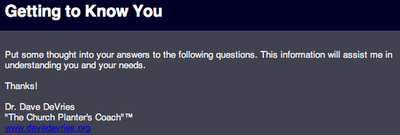
Things I accomplished since my last entry or session:
Things I had hoped to accomplish but did not:
Other events:
What I
feel is important for me right now in order to have success:
Things I intend to do before my next entry or coaching session:
Source: http://www.mylifecoach.com/progress_tracking_form.htm
Three Simple Ways to Utilize Forms in Google Docs
There are three primary ways that I am using FORMS in Google Docs to
enhance my coaching relationships.
1. Starting the Relationship
706
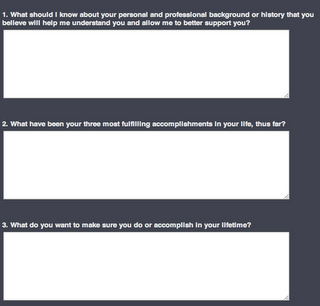
At the start of a coaching relationship, it is always helpful to get to
know the background, needs, goals, and dreams of a new client. I have
found that a simple questionnaire can provide valuable information
that allows me to see deeper into who they really are and who they
want to become.
Besides, name, address, phone, email, etc., ask questions that explore
the client's Background and Goals.
Sample Background Questions:
What should I know about your personal and professional
background or history that you believe will help me understand you
and allow me to better support you?
What have been your three most fulfilling accomplishments in your
life, thus far?
What do you want to make sure you do or accomplish in your
lifetime?
707
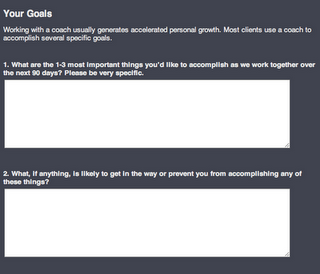
What habits, activities, or thought processes do you believe need to
be dropped, simplified or let go of, in order to truly move forward,
quickly?
What motivates you? What do you get energy from?
Is there anything else I should know? (e.g. are you currently in
therapy, on medication, in a Twelve Step program, etc.?)
Sample Goal Questions:
What are the 1-3 most important things you’d like to accomplish as
we work together over the next 90 days? Please be very specific.
What, if anything, is likely to get in the way or prevent you from
accomplishing any of these things?
What’s the most important thing you need from me as we work on
these objectives?
How will you know your investment in coaching has been
worthwhile?
708
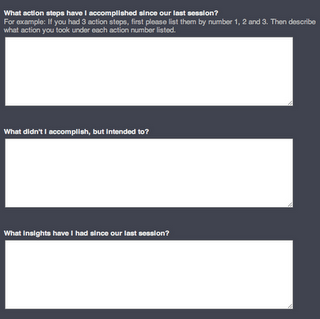
2. Preparing for Coaching Conversations
Before each coaching conversation, it is helpful for the client to begin to
prepare to be coached by reflecting on their action steps and the
progress they've made.
Sample Reflection Questions:
What action steps have I accomplished since our last session?
What didn't I accomplish, but intended to?
What insights have I had since our last session?
What challenges and/or problems am I facing now?
What opportunities are available to me right now?
Always include a question that helps your client to focus on the
upcoming coaching session:
For what do I want to use my coaching session?
709
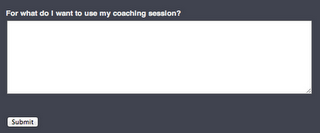
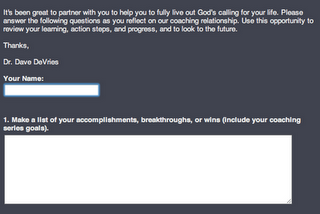
3. Completing a Coaching Series
At the end of an agreed upon series of coaching sessions, another form
can be helpful to guide the client to review the value of the coaching
series. The form is not enough by itself though; the follow-up
conversation is necessary to help the client process and capture
insights.
I always ask the client to consider the next step for them in regard to
coaching. I don't assume they will want to continue, but I always offer
them the option to do so. I also request a reference letter that I can
share with others. This is a great way to allow them to share how
they've benefited from coaching.
710
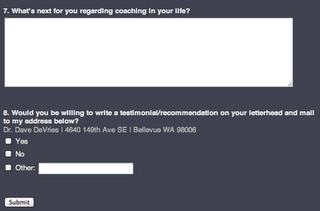

These are three simple ways that using forms with Google Docs has
enhanced my coaching relationships. I'm sure you can discover ways
that
this
approach
will
benefit
you
too.
Just remember, the form is a tool. It's not a substitute for your personal
interaction and communication with your client.
Source:
http://www.missionalchallenge.com/2012/02/how-forms-in-google-
docs-enhance-my.html
711
3.40 JOINING THE COACHEE THROUGH
MAINTENANCE, TRACKING AND MIMESIS
According to Minuchin before a counsellor can hope to intervene and
restructure a family to a more healthy way of functioning, she must first
“join” the family system. He also refers to this process as
“accommodation”.
He says: “The therapist’s methods of creating a therapeutic system and
positioning himself as its leader are known as joining operations.
(Minuchin (1974). Page 123)
Minuchin lays out three joining operations or methods that can be
employed in order to facilitate further work with the family in
treatment. These three operations are maintenance, tracking and
mimesis. We turn now to look at each of these.
Maintenance
According to Minuchin, maintenance “refers to the accommodation
technique of providing planned support for family structure, as the
therapist perceives and analyses it.” (Minuchin (1974) Basically, when
the therapist encounters the family he has needs to respect where they
find themselves at the moment. Their system and transactional
patterns may be far from perfect, but it is what works for them at
present, it supports each of the members identities and tasks in some
ways at least. Maintenance demands some modesty and patience on the
part of the therapist, especially while she is trying to really perceive
and understand how the family is organised and works, and how each
sub-system functions within it. The word “validate” comes to mind: the
therapist validates and accepts and even supports the family as it is
now so as to better help it move towards change when the time is right.
There is also a suspension of judgment in the maintenance operation
and a reluctance to rush into interpretations or diagnoses.
Interestingly, maintenance reminds me of Roger’s idea of unconditional
positive regard.
712
Tracking
According to Minuchin, tracking is where the therapist, “follows the
content of the family’s communications and behaviour and encourages
them to continue… In its simplist form it means to ask clarifying
questions, to make approving comments, or to elicit amplification of a
point.” (Minuchin (1974). With maintenance the therapist’s message
seems to be, “I see you, I support you in this, I validate you and don’t
judge”, in tracking the therapist’s message seems to be, “let me see if I
am understanding correctly…can you help me by clarifying that last
thing you said”. Tracking lets the therpist check with the family that she
is understanding correctly, and at the same time she is allowing the
family members to make clearer and more explicit the implicit feelings
and thoughts of the members.
Mimesis
According to Minuchin, “A therapist uses mimesis to accommodate to a
family’s style and affective [feeling range]. He adopts the family’s tempo
of communication slowing his pace, for example, in a family that is
accustomed to long pauses and slow responses. In a jovial family he
becomes jovial and expansive. In a family with a restrictive style, his
communication becomes sparse.” (Minuchin (1974)) The task with
mimesis is to join the family, to be engage in mutual acceptance with
them. To be taking into the confidences of a family in difficulty (or any
family for that matter) and be of help requires a lot of trust. Minuchin
mentions that mimesis can happen without the awareness of the
therapist as she endeavours to “tune into” her client family. When I
read about mimesis I thought of the concept of building rapport as
outlined in NLP.
Although a coach is not a therapist, the concept of joining coachees in
their world is very valuable when we want to fully understand how
they function and to accompany them through a process of change.
The therapist needs to discover what is going wrong and then plan how
to put it right. Only after the therapist has joined the family will she
713

move to the second phase of the therapy, which is: Restructuring the
family.
As Minuchin puts it: “Change is seen as occurring through the process
of the therapist’s affiliation with the family and his restructuring of the
family in a carefully planned way, so as to transform dysfunctional
transactional patterns.” (Minuchin (1974). Page 91
The therapist achieves two objectives by completing the joining process
successfully: she has won their trust in her and she has learned where
their transactional patterns are dysfunctional and may need to be
changed. From this position, having gotten to know the family, she can
decide how to bring about positive change. According to Minuchin,
“Patients move for three reasons. First, they are challenged in their
perception of reality. Second, they are given alternative possibilities
that make sense to them, and third, once they have tried out the
alternative transactional patterns, new relationships appear that are
self-reinforcing.” (Minuchin (1974), p 119
714

In order to bring about change the therapist has got a range of options
at her disposal. Minuchin lays out seven categories of restructuring
operations. They are:
· Actualising family transactional patterns
· Marking Boundaries
· Escalating Stress
· Assigning Tasks
· Utilising Symptoms
· Manipulating Mood
· Supporting, Educating and Guiding
Source:
http://cubicle-notes.tripod.com/essays/id9.html
Contact Vincent at : kylegariff@yahoo.com
715
3.41 PARADOXICAL INTERVENTIONS
“Don’t think at a pink elephant” - is a classic example of how thought
suppression works: counterproductively. You will think of a pink
elephant.
You know, this chapter isn't very interesting. I wouldn’t waste my time
reading about the fascinating and controversial world of paradoxical.
So, please skip this and kindly move along to the next blog. Okay, read if
you must, but definitely don’t ever put this technique into practice.
Paradoxical interventions involve prescribing the very symptom the
client wants to resolve. It's a complex concept often equated
with reverse psychology. For example: the client fears failure, so the
therapist asks the client to fail at something. A man has problems with
procrastination, so the therapist asks him to schedule one hour a day to
procrastinate. Your four year-old resists brushing her teeth so she's
told she isn't allowed, and may end up doing it out of spite. Or a woman
who can't initiate sex with her husband is advised not to initiate for a
month. Don't think about a pink elephant. It's asking for something in
order to achieve the opposite result.
The underlying principle is that we engage in behaviors for a reason,
which is typically to meet a need (rebellion, attention, a cry for help,
etc). In prescribing the symptom the therapist helps the client
understand this need and determine how much control (if any) they
have over the symptom. By choosing to manifest the symptom, they
may recognize they can create it, and therefore have the power to stop
or change it.
When to use a paradoxical intervention?
When there is a clear symptom or presenting problem that the client
believes is an involuntary behavior, such as depression, fears, pain,
even seizures.
716

What does it look like?
The client is asked to deliberately have the symptom at the coach’s
office and/or outside the office. Family members may be asked to
encourage, advise or reward the behavior. The idea is that, if a
symptom is involuntary, having it voluntarily means the behavior can
be controlled and is no longer a symptom. If the person can have it
voluntarily, this means he/she can also not have it voluntarily.
A variation is to ask the client to pretend to have the symptom. When a
person is pretending to have a symptom, they are not having the real
symptom. Secondary gain or positive reinforcement can be arranged
for the pretend behavior, so that it replaces the involuntary behavior.
The involuntary behavior is no longer needed in order to obtain the
secondary gain.
How does it help the client?
It helps the client to be in control of his/her behavior and experiences.
It's based on humor because the intent is for the patient to laugh at the
idea of bringing on an unpleasant symptom voluntarily and humor is
always therapeutic.
Source:
Published on January 23, 2010 by Ryan














